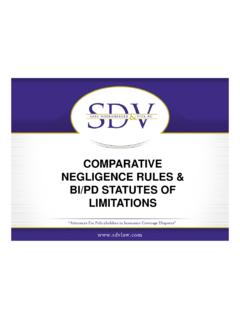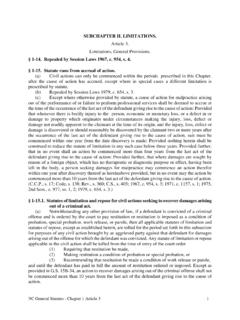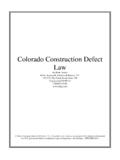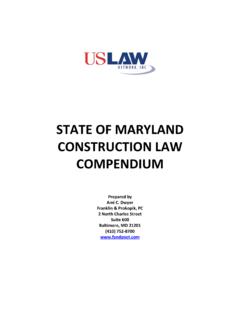Transcription of State By State Survey - sdvlaw.com
1 Connecticut California FloridaState By State Survey : The Right Choice for Policyholders of Limitations and repose for Construction - Related ClaimsFor more information or questions on statutes of limitation or repose , please contact us at This Survey is current as of 5/2018. This material is made available for gen-eral informational purposes only. The field of insurance law is ever-evolving, and courts may change their views at any time. Readers are advised to independently verify the information contained herein. This material is not intended to, and does not constitute, legal advice, nor is it intended to constitute a solicitation for the formation of an attor-ney-client relationship. Statutes of Limitations and repose | 2 Statutes of Limitations and repose for Construction - Related ClaimsA statute of repose is a limitation on a party s right to pursue a legal action after a specified time period has elapsed, regardless of when that party s injuries or damages actually accrue ( when the cause of action is discovered).
2 In the construction context, the statute typically begins to run from the date of substantial completion of the construction or improvement. Effectively, these statutes provide limitations on claims for construction defects and are intended to provide certainty as to exposure for construction related lawsuits. However, these statutes vary widely from State to State with regard to the limitation periods, what is covered by the statute, and whom the statute protects. A statute of repose is different from a statute of limitation because the time limitation begins to run from the date of substantial completion of the construction or improvement, whereas a statute of limitation typically does not begin to run until the injury or damage actually occurs (irrespec-tive of when the work was performed).This Survey is intended to provide an explanation of the statutes of limitation and repose in each State . For statutes of limitation, we have identified the applicable time limitation for claims of personal injury and property damages.
3 For statutes of repose , our chart identifies the following:1. The limitations period specified in the statute, which can range from 4 years to 15 years depending on the State , and 2. Whether the statute provides an extension of the limitations period, if the condition giving rise to the claim is discovered in the final year (or final two years) of the statutory time of Limitations and repose | 3 StateStatute of LimitationStatute of ReposePersonal InjuryProperty DamageStatuteTime LimitExtensionSummaryAlabama2 yearsAla. Code 6-2-38(l)2 yearsAla. Code 6-2-38(l)Ala. Code 6-5-2217 yearsN/AAn action must be brought within 2 years of the cause of action accruing or arising and no more than 7 years after the substantial comple-tion of con-struction of the improvement to the real , the 7 year period does not apply, where prior to the expiration of such 7 year period, the architect, engineer, or builder had actual knowledge that such defect or deficiency exists and failed to disclose such defect or defi-ciency to the person with whom the architect, engineer, or builder con-tracted to perform such service.
4 Alaska2 yearsAlaska Stat. yearsAlaska Stat. Stat. , et. seq10 yearsN/AA claim for personal injury, death, or property damage must be brought within 10 years of the earlier of substantial completion or the last act alleged to have caused the injury. This ten year limitation does not apply to claims of gross negligence. Note that there are also notice requirements on construction projects. Notice must be given within 1 year after the claimant discovers the defect, but that can occur within the 10 year limitation. Arizona2 yearsAriz. Rev. Stat. 12-5422 yearsAriz. Rev. Stat. 12-542 Ariz. Rev. Stat. 12-5528 years1 yearAn action may be brought up to 8 years after substantial completion of im-provement. If injury occurred during, or latent defect was not discovered until, 8th year after substantial completion, the action may be brought within 1 year after injury occurred or latent defect was discovered, but cannot be brought more than 9 years after substantial completion.
5 This statute does not apply to personal injury or wrongful death. Arkansas3 yearsArk. Code. 16-116-1033 yearsArk. Code. 16-116-103 Property Damage: Ark. Code 16-56-1125 yearsN/AAn action seeking damages for property damage may be brought up to 5 years after substantial completion of Injury:Ark. Code Ann. 16-56-1124 years1 yearAn action seeking damages for personal injury and wrongful death caused by any deficiency in the design, planning, supervision, or observation of con-struction or the construction and repairing of any improvement to real prop-erty shall be brought against any person performing or furnishing the design, planning, supervision, or observation of construction or the construction and repair of the improvement more than four (4) years after substantial comple-tion of the injury occurred during 3rd year after substantial completion, the action may be brought within 1 year after injury occurred, irrespective of date of death, but no more than 5 years after substantial completion.
6 Statutes of Limitations and repose | 4 StateStatute of LimitationStatute of ReposePersonal InjuryProperty DamageStatuteTime LimitExtensionSummaryCalifornia2 yearsCal. Civ. Code yearsCal. Civ. Code 338(c)Patent Defects: Cal Civ. Code years1 yearFor injury to property, personal injury, or wrongful death arising out of patent defects, an action must be brought within 4 years of substantial completion. If injury occurs during 4th year, the action may be brought within 1 year after date of injury, but in no event may such an action be brought more than 5 years after substantial Defects: Cal. Civ. Code yearsN/ALatent defects actions must be brought within 10 years of substantial com-pletion of improvement. This does not apply to actions based on willful mis-conduct or fraudulent concealment. This does not apply to limit causes of actions for personal injury or wrongful death caused by latent defects.
7 Colorado2 yearsColo. Rev. Stat. 13-80-1022 yearsColo. Rev. Stat. 13-80-102 Colo. Rev. Stat. 13- 80-1046 years2 yearsIn no event can the action be brought more than 6 years after substantial completion of improvement, but if the cause of action arises during 5th or 6th year after substantial completion, it shall be brought within 2 years after the date the cause of action yearsConn. Gen. Stat. 52-5843 yearsConn. Gen. Stat. 52-584 Conn. Gen. Stat. 52-584a7 years1 yearThe statute applies only to architects, professional engineers and land sur-veyors. An action may be brought up to 7 years after substantial completion of improvement. If injury occurs during 7th year after substantial completion, action may be brought within 1 year of date of injury, but no more than 8 years after substantial completion. Note: In a 2012 decision the Connecticut Supreme Court held that the statute of limitations and repose do not apply to actions brought by the State .
8 State of Connecticut v. Lombardo Brothers Mason Contractors, Inc., 307 Conn. 412 (2014)Delaware2 yearsDel. Code tit. 10 81192 yearsDel. Code tit. 10 Code tit. 10, 8127(b)6 yearsN/AAn action may be brought 6 years from the earliest of various dates set forth in statute ( , date of substantial completion). District of Columbia3 Code 12-3013 Code Code Ann. 12-31010 yearsN/AActions for personal injury, property damage, or wrongful death caused by defective improvements to real property must be brought within 10 years after substantial completion. Statutes of Limitations and repose | 5 StateStatute of LimitationStatute of ReposePersonal InjuryProperty DamageStatuteTime LimitExtensionSummaryFlorida4 yearsFla. Stat. (3)(a)4 yearsFla. Stat. (3)(c)4 yearsFla. Stat. (3)(c)10 years1 yearIn cases of latent defects, an action must be commenced within 10 years of latest of various listed dates ( , date of substantial completion).
9 If an action is brought in the 10th year after substantial completion, a compulsory counterclaim, cross-claim, or third-party claim that arises from the same con-duct or occurrence may be brought within 1 year of the filing of the original yearsGa. Code 9-3-334 yearsGa. Code 9-3-30Ga. Code 9-3-518 years2 yearsAn action must be brought within 8 years of substantial completion to recover damages for personal injury, property damage, or wrongful death. If injury occurs in the 7th or 8th year, an action in tort to recover damages for personal injury or wrongful death may be brought within 2 years, but in no event may an action be brought more than 10 years after substantial yearsHaw. Rev. Stat. 657-72 yearsHaw. Rev. Stat. 657-7 Haw. Rev. Stat. 657-810 yearsN/ANo action to recover damages for any injury to property, real or personal, or for bodily injury or wrongful death, arising out of any deficiency or neglect in the planning, esign, construction, supervision and administering of construc-tion, and observation of construction relating to an improvement to real prop-erty shall be commenced more than two years after the cause of action has accrued, but in any event not more than ten years after the date of completion of the improvement.
10 Idaho2 yearsIdaho Code 5-219(4)3 yearsIdaho Code 5-218(2),(3)Idaho Code 5-2416 yearsN/AActions will be deemed to have accrued and the statute of limitations shall begin to run as to actions against any person who preformed or finished the design, planning, supervision or construction of an improvement to real prop-erty, as follows:a. Tort actions, if not previously accrued, shall accrue and the applicable statute of limitations shall begin to run six (6) years after the final completion of the construction of such an improvementb. Contract actions shall accrue and the applicable statute of limitations shall begin to run at the time of final completion of construction of such an im-provementIllinois2 years735 Ill. 5/13-202 5 years735 Ill. 5/13-205735 Ill. Comp. Stat. 5/13-21410 years4 yearsNo action may be brought after 10 years from the time of such act or omis-sion, but if act or omission is discovered prior to the expiration of 10 years the plaintiff shall have 4 years to bring his action.








